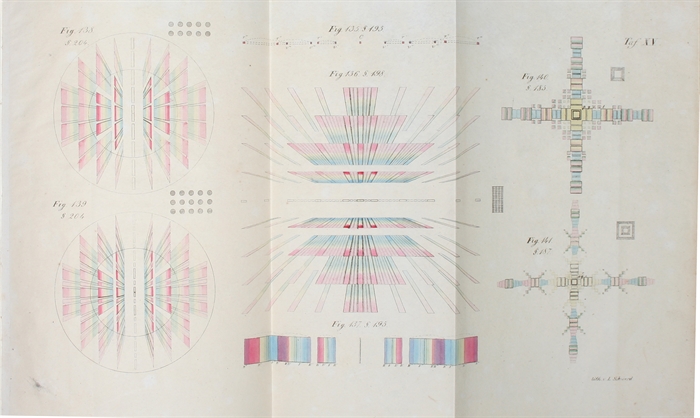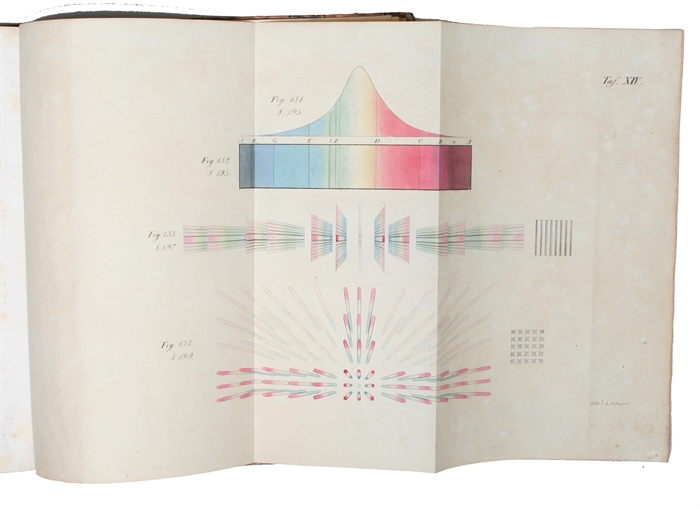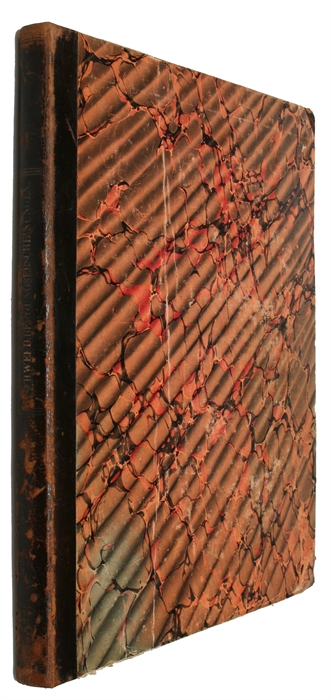ANTICIPATING THE DISCOVERY OF X-RAYS
SCHWERD, F. M.
Die Beugungserscheinungen aus den Fundamentalgesetzen der Undulationstheorie. Analytisch entwickelt und in Bildern dargestellt. Mit 18 zum Teil illuminirten Tafeln.
Mannheim, Schwan und Goetz, 1835. 4to. Contemporary halfcalf with marbled paper over boards. Half-title page supplied in facsimile. Library stamp and library-markings in old hand to title-page. XII (lacking the half-title, being pp. (I-II)) , 143, (8, -tables + errata) pp + 18 folded plates, two of which are hand-coloured. Spine and corners with wear. Internally some lighter brownspotting.
First edition of Schwerd's seminal paper on the diffraction from the fundamental laws of wave theory.
F. M. Schwerd, a pioneer of the early Fraunhofer diffraction, studied the intensity diffraction pattern of a circular aperture, also known as Airy disc.
Schwerd's theory presented in the present paper was highly influential. Max Von Laue, who won the Nobel Prize in Physics in 1914 for his discovery of the diffraction of X-rays by crystals, wrote in his autobiography: "Only shortly before this, when writing an article for Enzyklopaedie der mathematischen Wissenschaften, I had given the old theory of diffraction by an optical grating, which went back to Schwerd (1835), a new formulation in order that by applying the equation of the theory twice over, the theory of diffraction by a cross-grating could be obtained. I had only to write out this equation three times, corresponding to the three periodicities of a space lattice, so as to obtain the interpretation of the new discovery". (Max von Laue).
Even though Schwerd published many articles and teaching books for high school, non can be measured in importance with the present work. Since Fresnel had reduced the interference of transverse vibrations in the first quarter of the 19. century, nothing of importance was published until Schwerd theoretically described the colour phenomenon when light is being deflected by obstacles from their straight path and brought to mutual interference.
"Schwerd, though not well known to modern students, has had a great influence on optics through his monumental book on diffraction ... Die Beugungserscheinungen which he wrote in two years' spare time, is the classic comprehensive treatise on Fraunhofer diffraction ... Fraunhofer gave the laws which follow from his experiments but neither he nor J. F. W. Herschel developed the theory. This was done first by Schwerd and was viewed as a great triumph for wave theory over the emission theory of light. (Hoover, Richard B. and Franklin S. Harris, Jr.. Die Beugungserscheinungen: a Tribute to F. M. Schwerd's Monumental Work on Fraunhofer Diffraction, Applied Optics, Vol. 8, Issue 11, pp. 2161-2164 (1969)).
Honeyman: No. 2830, 2831 - Poggendorff, II, p. 878.
Order-nr.: 42684



